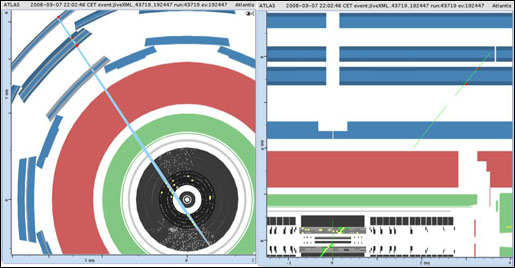
ATLAS e-News
23 February 2011
News from the pit
31 March 2008

The event display shows the expected 8 spacepoints on the SCT, the track segment in the TRT and reconstructed hits in the RPC.
After the Milestone 6 (M6) week finished up on March 10, the time has come to draw conclusions from this important step towards the global commissioning of the ATLAS detector. Heinz Pernegger, run coordinator for the silicon tracker, has been in charge of writing an extensive report for the executive board detailing the outcomes of the week.
While summarising the highlights of this report to ATLAS e-news, Heinz smiled with satisfaction: “All the sub-systems on ATLAS ran together amazingly stably at high speeds.” The elements of the detector that were tested fulfilled the expectations of those who packed the main and satellite ATLAS control rooms: “Detector elements, supplies, cooling systems, data taking, all worked well.” And for those parts that did not run so smoothly, ATLAS physicists and engineers have learnt a lot on how to debug the problems.
The M6 week kicked off on Monday March 3, with individual tests of each ATLAS sub-system. Previous Milestone weeks have seen the muon chambers and the tile and the liquid argon calorimeters being tested. In the M6 week, the silicon tracker came to play for the first time, with excellent results, Heinz said.
After each subsystem was tested separately, the challenge of detecting and reducing any interference that could arise from the integration of all the sub-detectors began on Friday March 7. The combined-test ran all over the weekend, and finished the following Monday at 9 am. It was a success throughout: “All the subsystems were integrated together and ran smoothly,” Heinz said. “We reconstructed cosmic rays in a very stable manner, and for the first time were able to track them from the silicon tracker and the TRT all the way through to the muon detector.”
During the combined test, a large part of each sub-detector ran without problems, the silicon tracker ran at 50% of its capacity, while the muon chambers and the tile calorimeter performed at 50% and 100% of their capacities, respectively. While the Endcap C was being refilled with liquid argon, and the Barrel was still under refurbishment, only Endcap A of the LAr Calorimeter was available to participate in the run.
High level trigger
The other major challenge of the M6 was to test the algorithms of the high level trigger, which will select relevant events after particle collisions. As the trigger merges information from all sub-detectors, Heinz explained, it was very important to test the algorithms with all the sub-detectors running simultaneously.
As the trigger Level 1 is the first sampling after the collisions, it processes the largest amount of data. In M6, Level 1 was tested at high trigger rates, which went from 8 to 10 kHz. When the ATLAS detector will see collisions, the level 1 rate is expected to go up to about 50 kHz: “We are not so far anymore from these high rates and we also realised that all the subsystems can run at higher rates” Heinz said.
The fact that not all the final pieces are in place yet prevented the system from running faster. These missing pieces, for example the lack of a compression algorithm that makes the data output abnormally large for the moment, led to a speed limit of 8 KHz. Nevertheless, Heinz was very optimistic: “All the sub-systems ran very stable together at 8 KHz and what it’s more important, now we know what we have to do to get to 50 KHz.”
Heinz, as many other ATLAS collaborators, cannot wait to see the whole detector running at this high speed. So, the next step in the commissioning process will be to test the detector at higher trigger rates.
ATLAS main control room and satellite control rooms
As Thorsten Wengler already emphasized in a previous ATLAS e-news, a key aim of the M6 exercise was finding the best way to organise physicists in the ATLAS control room. During the week, a lot of the subsystems started to use satellite control rooms; while the shift crew of every subsystem sat in the main control room, at the same time, other experts crowded the satellite rooms fitted out for their groups.
As during previous M-weeks, the control room was still sometimes flooded with people looking forward to following the developments of ATLAS. “It is nice to see such a big interest from the collaborators,” Heinz said. “But we need to fix better the way the control room will operate, so that people on shift don’t get distracted by others.”
However, Heinz was pleased: “Certainly, it is not the end of the story, but a good step towards the final operation of both, main and satellites control rooms.”
You can find the full report at http://indico.cern.ch/conferenceDisplay.py?confId=20607) (Indico Agenda of Technical Management Board (TMB) of March 13th)
